Small Home Gazette, Spring 2013
Answers to Your Toughest Bungalow Questions: tips for preventing break-ins; radon in basements
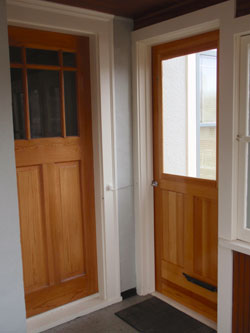
Thieves came through the storm door, right, and then through the back door, left.
A: We turned to general contractor Krishna Dorney, owner of Metropolis Construction, for his advice. Krishna writes:
I’d like to thank the editors for letting me take a crack at this problem. I have been called many times after break-ins to repair or replace doors and windows. There is a balance every homeowner has to strike between security and livability. We could make ourselves impervious to crime, but we would also live in a windowless bunker. Getting some natural light into a room or hallway might be worth the tradeoff of making your house easier to break into. But there are always strategies you can pursue to achieve a balance between crime prevention and a more elevated aesthetic.
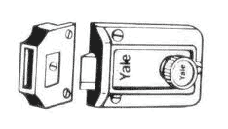 Regarding the problem of the kicked-in storm door, there are a few approaches you could take. The first would be something like a surface mounted deadbolt, commonly called a night latch. Unlike conventional deadbolts, these install easily on thinner doors. They are keyed on the outside and have a thumb turn on the inside, and typically have a switch which allows you to toggle between having it latch automatically behind you as the door shuts, or be locked with a key. This kind of latch could be put on a storm door to provide more secure locking.
Regarding the problem of the kicked-in storm door, there are a few approaches you could take. The first would be something like a surface mounted deadbolt, commonly called a night latch. Unlike conventional deadbolts, these install easily on thinner doors. They are keyed on the outside and have a thumb turn on the inside, and typically have a switch which allows you to toggle between having it latch automatically behind you as the door shuts, or be locked with a key. This kind of latch could be put on a storm door to provide more secure locking.
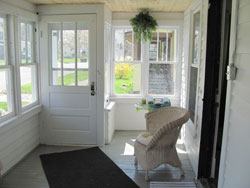 Another option is to replace the storm door with an exterior door. If your porch is already three-season and enclosed, this might not be too complicated. But if it’s more of an open porch there are some things to consider. First, the porch might be under-framed. Old-timers built houses to last, but strangely, they tended to really under-build porches. So you might have to firm things up a bit for your door to fit and operate correctly, and for interior and exterior trim to be in plane. Porch floors tend to slope and doors need to sit level. We work on a lot of porches that have sunk and sagged and have rotten decking and framing. It’s not always so easy to just pop a door into a porch and have it look seamless and historically accurate.
Another option is to replace the storm door with an exterior door. If your porch is already three-season and enclosed, this might not be too complicated. But if it’s more of an open porch there are some things to consider. First, the porch might be under-framed. Old-timers built houses to last, but strangely, they tended to really under-build porches. So you might have to firm things up a bit for your door to fit and operate correctly, and for interior and exterior trim to be in plane. Porch floors tend to slope and doors need to sit level. We work on a lot of porches that have sunk and sagged and have rotten decking and framing. It’s not always so easy to just pop a door into a porch and have it look seamless and historically accurate.
Also, a good quality exterior door to match your bungalow’s style would be costly, and the doors at the big box stores are low quality and don’t match most historic styles. To find a good entry door, try a lumberyard like Scherer Brothers, Siwek Lumber or Hiawatha Lumber. I’m particularly fond of Simpson and Buffelen brand exterior doors; they have some very nice styles for historic homes.
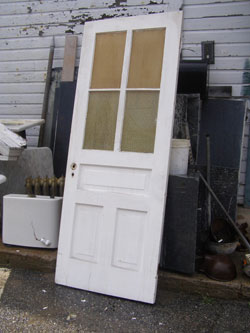 It’s also possible to find a door at a salvage yard, but you will need a good carpenter to make sure it fits and operates properly, and it might not be as energy efficient as a modern pre-hung door. And, unless you’re installing it yourself, working with old doors sometimes winds up costing more than a new one because so much labor is involved in refinishing it and fitting it properly. It’s possible to have a millwork shop fabricate a door for you, which could be weather-stripped and installed by any carpenter. Most cabinetmakers or woodworkers could turn out an entry door or storm door if you needed something custom to match or wanted to use a less common wood species.
It’s also possible to find a door at a salvage yard, but you will need a good carpenter to make sure it fits and operates properly, and it might not be as energy efficient as a modern pre-hung door. And, unless you’re installing it yourself, working with old doors sometimes winds up costing more than a new one because so much labor is involved in refinishing it and fitting it properly. It’s possible to have a millwork shop fabricate a door for you, which could be weather-stripped and installed by any carpenter. Most cabinetmakers or woodworkers could turn out an entry door or storm door if you needed something custom to match or wanted to use a less common wood species.
I should point out that you might enter a gray area with building codes if you have steps leading up to an exterior door on a porch. A building official may require a three-foot square landing and a porch light to meet code.
When it comes to securing back entrances from intruders, there’s always the issue of windows. Many bungalow floor plans have a back door that opens onto a stair landing or into the kitchen. Traditionally these doors had a solid wood panel on the bottom and a window on the upper half to admit some natural light. These windows are easily broken, and a burglar can then reach inside and undo the lock. Some people put a deadbolt with a keyed cylinder on both sides (instead of a thumb turn on the inside and a cylinder on the outside), the idea being that the burglar would not be able to open the door even if he broke the window and reached inside. However, this is a code violation and a fire hazard, as a person trapped in a burning house is locked in. Also, it seems like most people with this setup get tired of fumbling for keys and just leave a key in the inside cylinder all the time, thus negating it’s deterrent effect on the burglar.
Another option is to put a metal grate over the window or some bars, which is never attractive but can secure the opening. Yet another option is to replace the door with one that has smaller, higher windows so that it lets in some light but a burglar can’t reach in to open the lock.
 Also note that code requires that door glass be tempered. And any window within five feet of a door needs to have tempered glass as well. Although your bungalow’s windows are grandfathered in, if you need to replace glass you should opt for tempered. Not only is it much safer, it’s a great deal harder to break. I have seen a hammer bounce off a tempered glass window several times before it broke.
Also note that code requires that door glass be tempered. And any window within five feet of a door needs to have tempered glass as well. Although your bungalow’s windows are grandfathered in, if you need to replace glass you should opt for tempered. Not only is it much safer, it’s a great deal harder to break. I have seen a hammer bounce off a tempered glass window several times before it broke.
Lastly, you could opt for an alarm system. There are some affordable wireless options now that avoid having to run wires all over your home. Or you could choose my preferred solution—the German Shepherd. These dogs are lovable, cuddly and a great deterrent to break-ins.
Q: We recently tested our basement for radon and discovered there are high levels of the gas in several spots. What do you recommend?
A: The Star Tribune ran an article on radon February 12, 2013, titled “Minnesota is a hotbed for radioactive gas radon.” You can read the article online at www.startribune.com/feb-10-minnesota-is-hotbed-for-radioactive-gas-radon/190554621/.
In addition, what follows is an updated version of an article we ran in this newsletter in 2007.
Radon is a colorless, odorless radioactive gas that occurs naturally in the atmosphere as small amounts of radium and uranium in the soil break down. The problem comes when it’s trapped and concentrated in homes, particularly those closed up for several months during winter. The public tends to be apathetic about radon because it doesn’t kill instantly, like carbon monoxide.
It’s the second leading cause of lung cancer after smoking, and the Minnesota Department of Health estimates that one in three homes here have radon levels high enough to pose a significant health risk to homeowners exposed to it over many years. (Nationwide, it’s just 1 in 15 homes.) You’re at an even higher risk if you have finished living space in your basement, as that’s where radon enters the house and is most concentrated. The problem is serious enough that Minnesota Governor Mark Dayton proclaimed January 2013 as Radon Action Month.
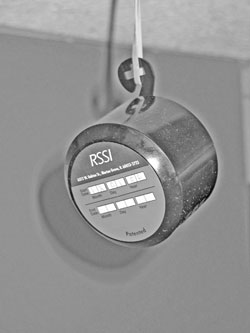
A long-term radon detection device hangs in a basement.
The good news is that testing the level of radon in your house is easy and inexpensive, and if you need to reduce radon gas, there are plenty of qualified contractors in the area to do the job.
There are two types of test kits. The short-term test (2 to 7 days) will give you a quick answer, but since they are not as accurate as long-term tests (90 days to one year), experts recommend performing both. Test kits are available at hardware stores, home-supply stores and online at http://mn.radon.com. Short-term kits ordered from this site are just $7.95; long-term kits are $21.95.
Radon is measured in something called “picoCuries” per liter of air. We’ll spare you the technical details of assessing levels and interpreting test results, but you can find additional information, including a list of contractors, at www.health.state.mn.us/divs/eh/indoorair/radon/index.html, or call 651-201-4601 or 800-798-9050.
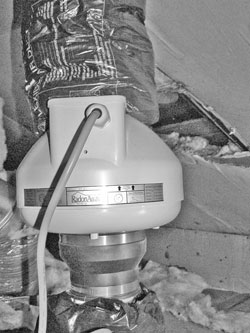
A fan in the attic pulls air from beneath the basement floor up and out through the roof.
If your home’s radon levels need to be reduced, mitigation falls into two categories: passive and active. Passive consists of sealing off air leaks in the basement to reduce the amount of radon seeping into your house; active means pulling radon out of your house using pipes and a fan.
Twin Cities Bungalow Club member Shelly Wiemann and her husband Bill have extensive experience with both types of mitigation. Several years ago, Shelly heard about the dangers of radon and grew concerned because she and Bill spent a good amount of time in their basement, which was finished as comfortable living space. She conducted a short-term test and found elevated radon levels. Unsure of where to turn, she sent an email to PBS’s Ask This Old House.
The show’s producers chose the Wiemanns’ home to demonstrate radon mitigation to viewers. (The segment ran in the fall of 2005.) They brought in local radon mitigation contractor and trainer Jack Bartholomew, Jr., as well as the Minnesota Department of Health’s radon program coordinator.
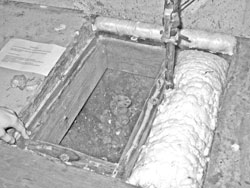
A high level of radon was found in a pit in the basement floor.
Bartholomew tested radon levels in several areas of the Weimanns’ basement. He found high levels in several areas, but two in particular: the dirt crawlspace under the bungalow’s finished porch and an open pit in the basement floor where a sewer cleanout pipe protrudes from the soil. This pit tested alarmingly high for radon: more than 100 picoCuries per liter of air. The acceptable level is 4 picoCuries per liter of air or less.
Workers sealed off the area under the porch by laying down a 6mm plastic vapor barrier, and enclosed the sewer pipe pit using expandable foam insulation and a thick Plexiglas cover, which can be removed to work on the plumbing.
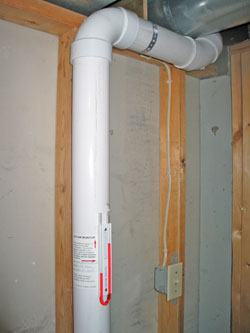 Remedies such as these will often not be enough to consistently keep radon levels down to an acceptable level, so an active system is also installed. Bartholomew installed such a system in the Wiemanns’ house. (Many of you may have seen the system in action if you visited their house during the 2012 Bungalow Club home tour.) In simple terms, it consists of a PVC pipe that runs from under the concrete basement floor, upward through the house (hidden in plumbing chases or closet corners) and out the roof. An electric fan in the attic draws air up through the pipe.
Remedies such as these will often not be enough to consistently keep radon levels down to an acceptable level, so an active system is also installed. Bartholomew installed such a system in the Wiemanns’ house. (Many of you may have seen the system in action if you visited their house during the 2012 Bungalow Club home tour.) In simple terms, it consists of a PVC pipe that runs from under the concrete basement floor, upward through the house (hidden in plumbing chases or closet corners) and out the roof. An electric fan in the attic draws air up through the pipe.
Shelly Wiemann says installing the system brought the unexpected benefit of making their basement dryer. “It’s pretty dry now—it used to be wet all the time,” says Shelly, referring to the soil around their sewer cleanout. “The fan is actually moving moisture out from under the basement floor.”
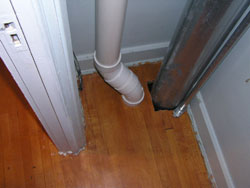 The cost of taking radon mitigation steps such as these will cost between $500 and $2,500, but the peace of mind you’ll get is invaluable.
The cost of taking radon mitigation steps such as these will cost between $500 and $2,500, but the peace of mind you’ll get is invaluable.











